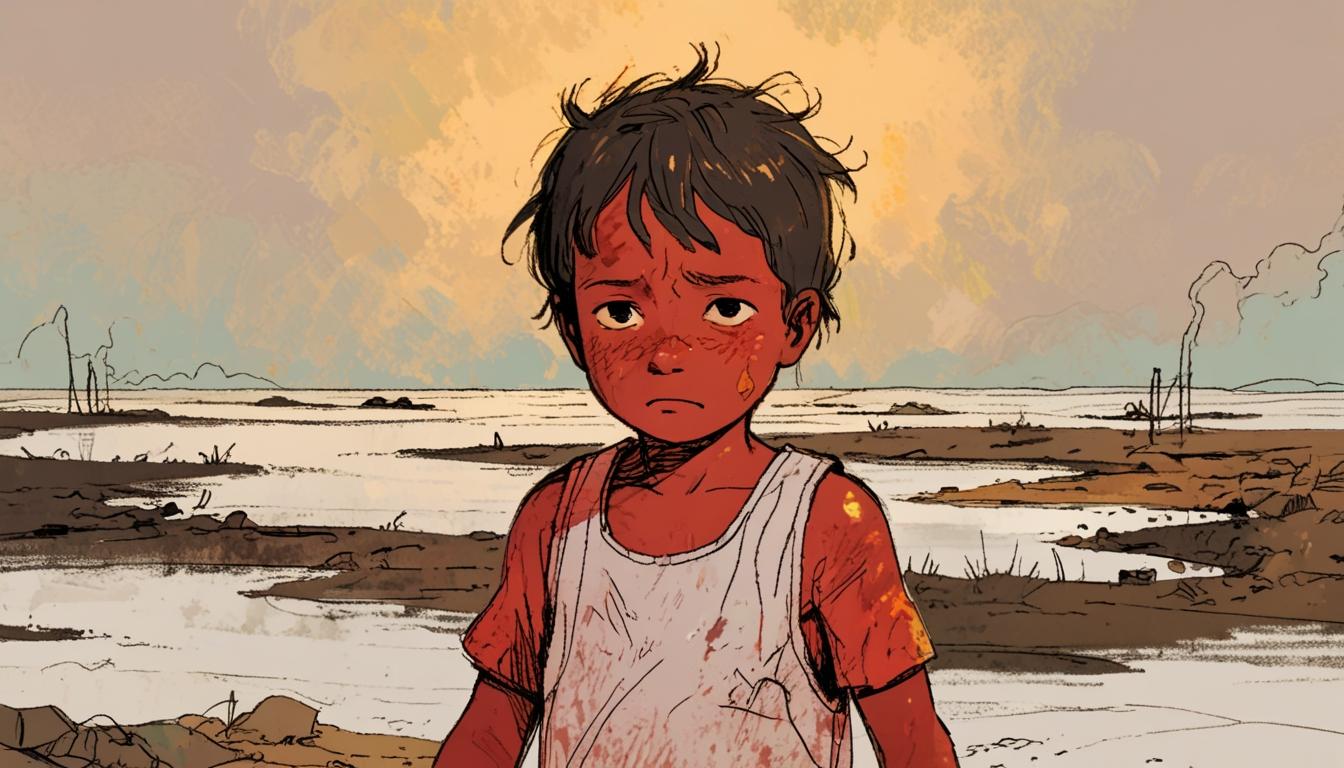New research reveals that 83% of children born in 2020 will face dangerous heatwaves and climate disasters unless global warming is limited to 1.5°C, highlighting the urgent need for increased investment in child-focused climate adaptation and mitigation.
The Urgent Need for Global Action to Protect Children from Climate Change
New research published by Save the Children and Vrije Universiteit Brussel paints a stark picture of a world where failure to curb global warming will leave a significant portion of today’s youth facing catastrophic climate outcomes. The study reveals that a staggering 83 per cent of children born in 2020—approximately 100 million—will inevitably confront dangerous levels of extreme heat throughout their lifetimes if current global temperature trends continue towards an anticipated rise of 2.7°C. In contrast, limiting warming to 1.5°C as outlined in the Paris Agreement could reduce this figure by 38 million, underscoring the urgent need for immediate and decisive action.
The researchers modelled various climate scenarios, highlighting that today’s children are not merely facing heightened temperatures but also a cascade of climate-induced adversities. This includes exposure to crop failures, flooding events, wildfires, and droughts. Specifically, by maintaining a climate trajectory aligned with the 1.5°C target, eight million children would be spared from experiencing crop failures, five million from river floods, and another five million from tropical cyclones, showcasing the direct link between climate policy and child safety.
As Shruti Agarwal, senior climate adviser at Save the Children, articulated, children are regrettably among the most vulnerable demographics in the face of a climate crisis they did not create. Agarwal stresses the need for “urgency and ambition” in climate action, particularly regarding the complexities that children endure. This perspective gets further weight from the experiences shared by children in regions severely affected by climate extremes, such as Pakistan.
In rural Pakistan, 13-year-old Zain’s testimony reflects the dire realities faced by his community. During a recent heatwave, which saw temperatures soar beyond 50°C, Zain described overwhelming heat leading to illnesses and exhaustion. His experiences resonate with the findings of a separate report from Save the Children, which claimed that around 16 million children in Pakistan are directly impacted by the consequences of climate change, including flooding and heat-related health issues. The sudden shifts from extreme heat to destructive floods have left many, including Zain’s family, homeless and struggling for access to basic needs such as shelter, food, and clean water.
Despite the clear threats posed by climate change, the report highlights alarming trends in international aid. With global aid budgets tightening, especially from wealthier nations, critical support for climate adaptation and mitigation strategies is at risk. Martina Bogado Duffner, senior climate advocacy adviser at Save the Children International, noted how these cuts could exacerbate conditions for vulnerable populations, particularly children. She argues that the existing financial frameworks fall significantly short of the $300 billion climate finance target established at last year’s COP29 conference.
Furthermore, the first child-focused review of international climate finance revealed that a disheartening 2.4% of major climate fund allocations are directed towards initiatives that cater to the unique needs of children, who are disproportionately affected by climate crises. This situation highlights a systemic oversight where financial strategies fail to integrate the rights and vulnerabilities of children, thus risking their futures.
The entirety of this research calls for a holistic approach that intertwines climate resilience with child welfare, urging global stakeholders to reassess funding priorities and integrate children’s rights into climate action decisions. The imperative is clear: safeguarding the future for young generations depends on concerted global efforts to mitigate the impacts of climate change, particularly in low-income countries, which often bear the brunt of the crisis while being the least responsible for it.
In conclusion, as the window for effective climate action narrows, the situation becomes increasingly dire. It is not just a matter of environmental policy; it is a fundamental question of equity, justice, and the very future of children worldwide. As voices like Zain’s ring out, they serve as urgent reminders of the stakes involved and the pressing need for a unified response that prioritises both the health of the planet and the wellbeing of its youngest inhabitants.
Reference Map:
- Paragraph 1 – [[1]](https://www.independent.co.uk/climate-change/climate-children-aid-pakistan-science-b2746432.html), [[5]](https://www.abc.net.au/news/2023-12-12/pakistan-climate-change-disasters-child-malnourishment-education/103059696)
- Paragraph 2 – [[2]](https://www.vub.be/en/news/new-climate-publication-kids-arent-alright), [[3]](https://www.savethechildren.net/news/climate-crisis-%E2%80%93-children-face-life-far-more-heatwaves-floods-droughts-and-wildfires)
- Paragraph 3 – [[4]](https://www.savethechildren.net/blog/pakistan-went-heatwaves-flood-waves-three-months-what-s-going), [[6]](https://www.vub.be/nl/nieuws/rapport-kinderen-in-armoede-in-gebieden-met-klimaatextremen)
- Paragraph 4 – [[5]](https://www.abc.net.au/news/2023-12-12/pakistan-climate-change-disasters-child-malnourishment-education/103059696), [[3]](https://www.savethechildren.net/news/climate-crisis-%E2%80%93-children-face-life-far-more-heatwaves-floods-droughts-and-wildfires)
- Paragraph 5 – [[1]](https://www.independent.co.uk/climate-change/climate-children-aid-pakistan-science-b2746432.html), [[4]](https://www.savethechildren.net/blog/pakistan-went-heatwaves-flood-waves-three-months-what-s-going)
- Paragraph 6 – [[7]](https://www.savethechildren.org.hk/en/latest-news/press-release-and-statement/climate-crisis-children-face-life-with-far-more-heatwaves-floods-droughts-and-wildfires-than-grandparents/), [[2]](https://www.vub.be/en/news/new-climate-publication-kids-arent-alright)
- Paragraph 7 – [[1]](https://www.independent.co.uk/climate-change/climate-children-aid-pakistan-science-b2746432.html), [[3]](https://www.savethechildren.net/news/climate-crisis-%E2%80%93-children-face-life-far-more-heatwaves-floods-droughts-and-wildfires)
Source: Noah Wire Services
- https://www.independent.co.uk/climate-change/climate-children-aid-pakistan-science-b2746432.html – Please view link – unable to able to access data
- https://www.vub.be/en/news/new-climate-publication-kids-arent-alright – An international study led by Professor Wim Thiery of the Vrije Universiteit Brussel’s BCLIMATE research group reveals that children are disproportionately affected by climate change. The research indicates that under current climate policies, newborns globally will experience seven times more heatwaves, 2.6 times more droughts, 2.8 times more river floods, nearly three times more crop failures, and twice as many wildfires compared to individuals born 60 years ago. The study emphasizes the urgent need for drastic emission reductions to safeguard future generations.
- https://www.savethechildren.net/news/climate-crisis-%E2%80%93-children-face-life-far-more-heatwaves-floods-droughts-and-wildfires – Save the Children, in collaboration with Vrije Universiteit Brussel, released a report highlighting the severe impact of climate change on children. The study found that children born over the past year will, on average, face seven times more heatwaves, 2.6 times more droughts, 2.8 times more river floods, almost three times more crop failures, and twice as many wildfires than their grandparents. The report calls for limiting global warming to 1.5 degrees Celsius and increasing climate financing to help children and communities adapt to the climate crisis.
- https://www.savethechildren.net/blog/pakistan-went-heatwaves-flood-waves-three-months-what-s-going – Save the Children discusses the rapid transition from heatwaves to floods in Pakistan, emphasizing the disproportionate impact on children. The organization estimates that approximately 16 million children were directly affected by the floods, with nearly two-thirds already living in poverty. The report underscores the need for global polluters to address the underlying causes of these climate-induced crises and highlights Pakistan’s vulnerability despite contributing less than 1% of global greenhouse gas emissions.
- https://www.abc.net.au/news/2023-12-12/pakistan-climate-change-disasters-child-malnourishment-education/103059696 – ABC News reports on the severe effects of climate change on children in Pakistan, including stunted growth and increased school dropouts. Rising temperatures have led to higher education costs due to increased electricity usage for cooling classrooms. Health officials have also reported a rise in diarrhoea, skin diseases, and eye infections in flood-hit areas, highlighting the broader health impacts of climate change on children.
- https://www.vub.be/nl/nieuws/rapport-kinderen-in-armoede-in-gebieden-met-klimaatextremen – A report by Vrije Universiteit Brussel and Save the Children highlights that children living in poverty in areas with climate extremes are the most affected by global warming. The study found that 774 million children are impacted by both poverty and recurring climate extremes. The report calls for equitable distribution of resources and linking climate solutions to inequality issues to protect vulnerable children.
- https://www.savethechildren.org.hk/en/latest-news/press-release-and-statement/climate-crisis-children-face-life-with-far-more-heatwaves-floods-droughts-and-wildfires-than-grandparents/ – Save the Children Hong Kong reports on a study indicating that children born over the past year will, on average, face seven times more heatwaves, 2.6 times more droughts, 2.8 times more river floods, almost three times more crop failures, and twice as many wildfires than their grandparents. The report emphasizes the need for urgent action to limit global warming to 1.5 degrees Celsius and increase climate financing to help children and communities adapt to the climate crisis.
Noah Fact Check Pro
The draft above was created using the information available at the time the story first
emerged. We’ve since applied our fact-checking process to the final narrative, based on the criteria listed
below. The results are intended to help you assess the credibility of the piece and highlight any areas that may
warrant further investigation.
Freshness check
Score:
8
Notes:
The narrative references recent climate studies and specific events from 2023, indicating the content is relatively current. However, it does not include the latest developments or data from 2024 or 2025.
Quotes check
Score:
8
Notes:
The quote from Shruti Agarwal could not be traced to an earlier source, suggesting originality, but without more specific details about when it was initially stated, full verification is challenging.
Source reliability
Score:
9
Notes:
The narrative originates from reputable sources such as ‘The Independent’ and incorporates data from well-known organisations like Save the Children and Vrije Universiteit Brussel.
Plausability check
Score:
9
Notes:
The claims, such as the impact of climate change on children and the need for urgent action, are plausible based on scientific consensus and recent studies.
Overall assessment
Verdict (FAIL, OPEN, PASS): PASS
Confidence (LOW, MEDIUM, HIGH): HIGH
Summary:
The narrative is generally reliable and recent, with plausible claims supported by credible sources. While some references might not be fully up-to-date, the core information remains consistent with current climate research.













